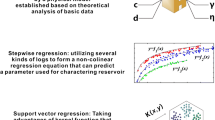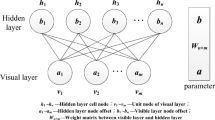Abstract
This study utilized the deep belief network (DBN) model to predict permeability, which has been shown to be superior in data fitting compared to traditional machine learning models. However, the DBN model requires optimization of multiple hyper-parameters in modeling, making it challenging to ensure that the model parameters are optimal. To address this issue, the improved quantum-behaved particle swarm optimization (IQPSO) algorithm was introduced to optimize the DBN parameters and propose an IQPSO–DBN model. The research focused on the tight sandstone reservoirs of the Baiyanghe Formation in the geothermal field of Zhangye Basin, Northern China. Two experiments were designed to evaluate the prediction ability of the IQPSO–DBN model, and it was compared with other models such as stepwise iteration, support vector regression, group method of data handling, and extreme gradient boosting methods. The results demonstrated that the IQPSO–DBN model can effectively predict permeability in pure data drive, and it had the lowest prediction error compared to the other models. Therefore, the combination of the DBN model and the IQPSO algorithm can be a powerful tool for permeability prediction, which can have significant implications in geothermal fields and other related fields.












Similar content being viewed by others
Notes
* *1 mD = 1 millidarcy = 9.869233-16 m2
References
Akande, K., Owolabi, T., Olatunji, S., & Abdulraheem, A. (2016). A hybrid particle swarm optimization and support vector regression model for modelling permeability prediction of hydrocarbon reservoir. Journal of Petroleum Science and Engineering, 150, 43–53.
Aminian, K., & Ameri, S. (2005). Application of artificial neural networks for reservoir characterization with limited data. Journal of Petroleum Science and Engineering, 49(3–4), 212–222.
Arsalan, A. O., & Richard, G. (2017). Integration of spectral, spatial and morphometric data into lithological mapping: A comparison of different Machine Learning Algorithms in the Kurdistan Region, NE Iraq. Journal of Asian Earth Science, 146, 90–102.
Bhatt, A., & Helle, H. B. (2002). Committee neural networks for porosity and permeability prediction from well logs. Geophysical Prospecting, 50, 645–660.
Cheng, X., Cheng, Y., Cheng, J., & Sun, Q. (2019). Geophysical logging system based on machine learning and big data technology. Journal of Xi’an Shiyou University (Natural Science Edition), 34(06), 108–116.
Ding, B., Wu, X., Zhang, L., Zhong, J., & Liu, Y. (2015). Research on optimization method of shield tunnel construction parameters based on DBN. Chinese Journal of Rock Mechanics and Engineering, 34(S1), 3215–3222.
Ding, J., & Jensen, J. (2016). A new approach for permeability prediction with NMR measurements in tight formations. SPE Reservoir Evaluation & Engineering, 19(03), 481–493.
Farzi, S., & Dastjerdi, A. (2010). Leaf constrained minimal spanning trees solved by modified quantum-behaved particle swarm optimization. Artificial Intelligence Review, 34(1), 1–17.
Frank, M., Jerry, L., & Larry, W. (2020). Comparison of permeability predictions on cemented sandstones with physics-based and machine learning approaches. Journal of Natural Gas Science and Engineering, 77, 103244–103244.
Gu, Y., Zhang, D., Ruan, J., Wang, Q., Bao, Z., & Zhang, H. (2022). A new model for permeability prediction in oil and gas reserve evaluation. Progress in Geophysic, 49, 431–413.
Helle, H. B., Bhatt, A., & Ursin, B. (2001). Porosity and permebility prediction from wireline logs using artificial neural networks: a North Sea case study. Geophysical Prospecting, 49, 431–444.
Hinton, G., & Salakhutdinov, R. (2006). Reducing the dimensionality of data with neural networks. Science, 313(5786), 504–507.
Ju, M. (2020). Parameter optimization of DBN model based on PSO algorithm. Foreign Electronic Measurement Technology, 39(03), 12–16.
Kumar, N., Rahman, M., Duary, A., Mahato, S., & Bhunia, A. (2021). A new QPSO based hybrid algorithm for bound-constrained optimisation problem and its application in engineering design problems. International Journal of Computing Science and Mathematics, 12(4), 385–412.
Le, A., Zhou, R., Tang, L., & Chen, R. (2018). A DBN-based resampling SVM ensemble learning paradigm for credit classification with imbalanced data. Applied Soft Computing, 69, 192–202.
Li, J., Wang, W., Chen, G., & Han, Z. (2022). Spatiotemporal assessment of landslide susceptibility in Southern Sichuan, China using SA-DBN, PSO-DBN and SSA-DBN models compared with DBN model. Advances in Space Research, 69(8), 3071–3087.
Li, T., Zuo, R., Xiong, Y., & Peng, Y. (2020). Random-drop data augmentation of deep convolutional neural network for mineral prospectivity mapping. Natural Resources Research, 30(1), 1–12.
Lim, J. (2005). Reservoir permeability determination using artificial neural network. Journal of the Korean Geosynthetic Society, 40, 232–238.
Majid, B., & Hadi, R. (2019). Reservoir rock permeability prediction using SVR based on radial basis function kernel. Carbonates and Evaporites, 34(3), 699–707.
Meenigi, R., & Kalludi, N. (2020). Optimal DBN-based distributed attack detection model for internet of things. International Journal of Communication Systems, 33(17), 225–238.
Muralidharan, R., Vallavaraj, A., Mahanti, G., & Mahanti, A. (2014). QPSO versus BSA for failure correction of linear array of mutually coupled parallel dipole antennas with fixed side lobe level and VSWR. Advances in Electrical Engineering, 20, 1–7.
Ngo, V., Lu, V., & Le, V. (2018). A comparison of permeability prediction methods using core analysis data for sandstone and carbonate reservoirs. Geomechanics and Geophysics for Geo-Energy and Geo-Resources, 4(2), 129–139.
Nosjean, N., Khamitov, Y., Rodriguez, S., & Yahia-Cherif, R. (2019). Fracture corridor identification through 3d multifocusing to improve well deliverability, an Algerian tight reservoir case study. Solid Earth Sciences, 5(1), 31–49.
Ojo, S., Olatinsu, O., & Ozebo, V. (2018). Rock type based poroperm and continuous permeability predictions in a tight gas formation. Ife Journal of Science, 20(1), 1–15.
Paulin, C., Selouani, S., & Hervet, R. (2016). Audio steganalysis using deep belief networks. International Journal of Speech Technology, 19(3), 585–591.
Rezaee, R., & Ekundayo, J. (2022). Permeability prediction using machine learning methods for the CO2 injectivity of the precipice sandstone in surat basin. Australia. Energies, 15(6), 2053–2053.
Saemi, M., Ahmadi, M., & Yazdian, V. A. (2007). Design of neural networks using genetic algorithm for the permeability estimation of the reservoir. Journal of Petroleum Science and Engineering, 59(1–2), 97–105.
Shu, Y., Sang, S., Lin, Y., Zhou, X., Wang, H., & Wang, Z. (2021). The influence of magmatic-hydrothermal activities on porosity and permeability of sandstone reservoirs in the Linxing area, Ordos Basin, Northern China. Journal of Asian Earth Science, 213, 104741.
Silvia, R., Giovanni, A., & Mariacarla, S. (2020). Working together: a DBN approach for individual and group activity recognition. Journal of Ambient Intelligence and Humanized Computing, 11, 6007–6019.
Spichak, V., & Zakharova, O. K. (2022). Permeability estimating beyond boreholes from electrical conductivity data determined from magnetotelluric sounding: Soultz-sous-Forets site (France) case study. Geothermics, 105, 1102513.
Swati, D., & Rajabhushnam, C. (2019). Iris recognition at-a-distance by means of chronological MBO-based DBN. International Journal of Innovative Technology and Exploring Engineering, 8(12), 4540–4552.
Tang, M., Zhao, Q., Ding, S., Wu, H., Li, L., & Long, W. (2020). An improved LightGBM algorithm for online fault detection of wind turbine gearboxes. Energies, 13(4), 1–16.
Urang, J. G., Ebong, E. D., Akpan, A. E., & Akaerue, E. I. (2020). A new approach for porosity and permeability prediction from well logs using artificial neural network and curve fitting techniques: A case study of Niger Delta, Nigeria. Journal of Applied Geophysics, 183, 1–14.
Verma, K. A., Cheadle, A. B., Routray, A., Mohanty, K. W., & Mansinha, L. (2012). Porosity and permeability estimation using neural network approach from well log. Canada: Geoconvention Vision.
Wu, J. (2019). Research on comprehensive logging evaluation method for tight gas reservoirs. China University of Geosciences.
Yan, X., Gu, H., Xiao, Y., Ren, H., & Ni, J. (2019). Application of XGBoost algorithm in log interpretation of tight sandstone gas reservoirs. Petroleum Geophysical Exploration, 54(02), 447–455.
Yang, K., Wang, F., Zeng, F., Zhao, J., & Wang, C. (2020). Permeability prediction method based on fractal features of digital cores. Journal of Jilin University (Earth Science Edition), 50(04), 1003–1011.
Ye, C., Yuan, X., & Zang, X. (2019). Two hypotheses and test assumptions based on quantum-behaved particle swarm optimization (QPSO). Cluster Computing, 22(6), 14359–14366.
Zanganeh, K. (2022). Permeability prediction of heterogeneous carbonate gas condensate reservoirs applying group method of data handling. Marine and Petroleum Geology, 139, 105597.
Zhang, G., Wang, Z., Li, H., Sun, Y., Zhang, Q., & Chen, W. (2018). Permeability prediction of isolated channel sands using machine learning. Journal of Applied Geophysics, 159, 605–615.
Zhao, J., Zhang, T., He, S., Zhang, H., Han, D., & Tang, Z. (2020). Preliminary study on prediction of reservoir permeability depth belief network model based on parameter optimization. Reservoir Evaluation and Development, 11(04), 577–585.
Zhu, L., Zhang, C., & He, X. (2017). Permeability prediction of tight sandstone reservoirs based on improved BPNN and T2 full spectrum. Petroleum Geophysical Prospecting, 56(5), 727–734.
Acknowledgments
We are very grateful to Professor Yu Guolong for his guidance on QPSO algorithm through e-mail and some data support of Gansu Provincial Bureau of Geology.
Author information
Authors and Affiliations
Corresponding author
Ethics declarations
Conflict of Interest
The authors declare that they have no known competing financial interests or personal relationships that could have appeared to influence the work reported in this paper.
Rights and permissions
Springer Nature or its licensor (e.g. a society or other partner) holds exclusive rights to this article under a publishing agreement with the author(s) or other rightsholder(s); author self-archiving of the accepted manuscript version of this article is solely governed by the terms of such publishing agreement and applicable law.
About this article
Cite this article
Zhang, H., Wu, W. DBN with IQPSO Algorithm for Permeability Prediction: A Case Study of the Lizhai Geothermal Field, Zhangye Basin (Northern China). Nat Resour Res 32, 1941–1957 (2023). https://doi.org/10.1007/s11053-023-10240-1
Received:
Accepted:
Published:
Issue Date:
DOI: https://doi.org/10.1007/s11053-023-10240-1




